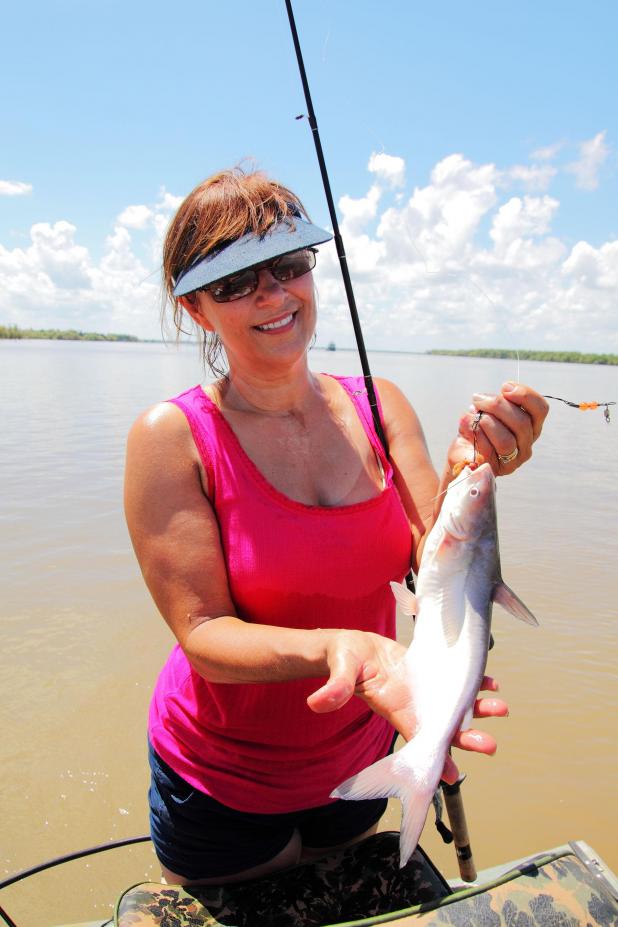
The Review/John K. Flores
The author’s wife shows a coastal blue catfish.
John K. Flores: After the rain, the catfish are biting
One thing about being an outdoor writer is how many fishing reports I receive during any given week throughout the year. Many of them come via social media, but a lot of them still come face-to-face.
Those usually start out, “Hey John. Have you been doing any fishing?”
Like most people, sometimes I have and sometimes I haven’t. Essentially, I get 52 weekends each year, and now that I have grandchildren, there seems to be a lot more going on the older I get.
One of those face-to-face reports came this past Sunday in the foyer about 10 minutes before church service started. One of our parishioners and his wife had fished the day before in the marsh just south of Burns Point and caught 43 blue catfish. Not bad for an August outing to say the least, but not uncommon when the conditions are right.
The natural flow of the Atchafalaya River is westerly, therefore, the coastal waters west of the river are usually a lot fresher than those east of the river, particularly in the spring. The amount of nutrients carried from the rich farmland that the river drains is the foundation for the food web. Blue catfish take advantage of the available estuarine animals that benefit from these nutrients.
The estuary is populated with organisms like juvenile crabs and shrimp, Gulf menhaden, flatfish like hogchokers, and all sorts of minnows.
Though still considered freshwater, bayous that open into Atchafalaya Bay have a slightly higher salinity level; somewhere in the 1½ to 2 parts per thousand range. Able to tolerate higher salinity, blue cats are the more common species of catfish you’ll catch in these stretches of bayous.
Typically, by mid-summer the river has fallen well below flood stage and by late summer/early fall the brackish water marshes have slightly higher salinity.
Several years ago, I interviewed then-Louisiana Department of Wildlife and Fisheries freshwater biologist Mike Walker. Walker cited a study conducted on Rockefeller Refuge near Grand Chenier in 1965 by W. Guthrie Perry Jr.
Walker said, “Channel and blue catfish have been found in past studies to have the same tolerance to salinity. Studies here in
Louisiana have found twice as many blue catfish occupy the brackish waters along the coast, as do channel catfish. Since the salinity tolerance is close to being the same, there must be a difference in prey preference or habitat preference other than salinity that causes this difference in numbers.”
Blue catfish also tend to prefer deeper moving water closer to main river systems, such as the Atchafalaya River that feeds them. To the west of Belle Isle is the deep Wax Lake Outlet also known as the Calumet Cut. The Cut drains a significant portion of the Atchafalaya River and provides a steady flow of freshwater into the region. As a result, both of the major drainages create a virtual haven for catfish.
Along the brackish water bays the salinity level of the water can fluctuate depending on the time of year and weather conditions, particularly rain.
Perry’s studies note that channel catfish don’t tolerate salinity levels above 1.7 ppt average. And, blue catfish only tolerate slightly more at 3.7 ppt. Yet, both have been found in water where the salinity levels averaged 11.4 ppt.
However, Perry also noted after heavy rains both species tended to follow the freshwater as saltwater was pushed back. The one thing we’ve had a lot of lately is rain. In short, there is plenty of freshwater in the local bays right now. No wonder my fellow parishioner and his spouse had a great outing last weekend.
Anglers looking for a few locations to catch catfish, both blue and channels, should start on the west side of East Cote Blanche
Bay near Point Moroon at the mouth of Bayou Carlin, Humble Canal and Jackson Bayou on the west side of the Bay. On the east side try the mouth of British-American Canal, Yellow Bayou and Oyster Bayou. A falling tide is preferable, but I’ve caught blues and channels on a rising tide in these locations.
From Point Chevreuil eastward towards the Calumet spillway try the mouths of Big Beach and Little Beach bayous. On the east side of Belle Isle try the mouth of Big Lacassine Bayou in Little Bay and any of the bayous in East Bay near the Atchafalaya River.
Don’t limit yourself only to the mouth of these outlets. By traveling and setting on anchor a few reaches up, any of these navigable bayous and canals will also produce fish. You might be surprised what you’ll catch. What’s more, with all the rain in the forecast, the conditions for catching a mess of blue catfish may not be better this month.
John Flores is the Morgan City Review’s outdoor writer. He can be contacted at gowiththef lo@cox.net.
